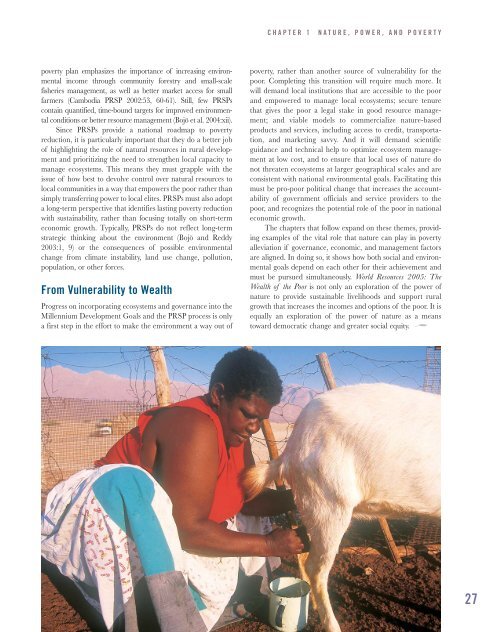jp8589 WRI.qxd - World Resources Institute
jp8589 WRI.qxd - World Resources Institute
jp8589 WRI.qxd - World Resources Institute
Create successful ePaper yourself
Turn your PDF publications into a flip-book with our unique Google optimized e-Paper software.
CHAPTER 1<br />
NATURE, POWER, AND POVERTY<br />
poverty plan emphasizes the importance of increasing environmental<br />
income through community forestry and small-scale<br />
fisheries management, as well as better market access for small<br />
farmers (Cambodia PRSP 2002:53, 60-61). Still, few PRSPs<br />
contain quantified, time-bound targets for improved environmental<br />
conditions or better resource management (Bojö et al. 2004:xii).<br />
Since PRSPs provide a national roadmap to poverty<br />
reduction, it is particularly important that they do a better job<br />
of highlighting the role of natural resources in rural development<br />
and prioritizing the need to strengthen local capacity to<br />
manage ecosystems. This means they must grapple with the<br />
issue of how best to devolve control over natural resources to<br />
local communities in a way that empowers the poor rather than<br />
simply transferring power to local elites. PRSPs must also adopt<br />
a long-term perspective that identifies lasting poverty reduction<br />
with sustainability, rather than focusing totally on short-term<br />
economic growth. Typically, PRSPs do not reflect long-term<br />
strategic thinking about the environment (Bojö and Reddy<br />
2003:1, 9) or the consequences of possible environmental<br />
change from climate instability, land use change, pollution,<br />
population, or other forces.<br />
From Vulnerability to Wealth<br />
Progress on incorporating ecosystems and governance into the<br />
Millennium Development Goals and the PRSP process is only<br />
a first step in the effort to make the environment a way out of<br />
poverty, rather than another source of vulnerability for the<br />
poor. Completing this transition will require much more. It<br />
will demand local institutions that are accessible to the poor<br />
and empowered to manage local ecosystems; secure tenure<br />
that gives the poor a legal stake in good resource management;<br />
and viable models to commercialize nature-based<br />
products and services, including access to credit, transportation,<br />
and marketing savvy. And it will demand scientific<br />
guidance and technical help to optimize ecosystem management<br />
at low cost, and to ensure that local uses of nature do<br />
not threaten ecosystems at larger geographical scales and are<br />
consistent with national environmental goals. Facilitating this<br />
must be pro-poor political change that increases the accountability<br />
of government officials and service providers to the<br />
poor, and recognizes the potential role of the poor in national<br />
economic growth.<br />
The chapters that follow expand on these themes, providing<br />
examples of the vital role that nature can play in poverty<br />
alleviation if governance, economic, and management factors<br />
are aligned. In doing so, it shows how both social and environmental<br />
goals depend on each other for their achievement and<br />
must be pursued simultaneously. <strong>World</strong> <strong>Resources</strong> 2005: The<br />
Wealth of the Poor is not only an exploration of the power of<br />
nature to provide sustainable livelihoods and support rural<br />
growth that increases the incomes and options of the poor. It is<br />
equally an exploration of the power of nature as a means<br />
toward democratic change and greater social equity. <br />
27

















